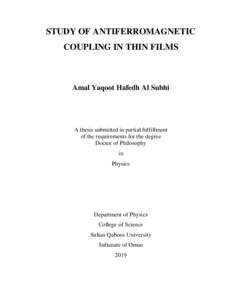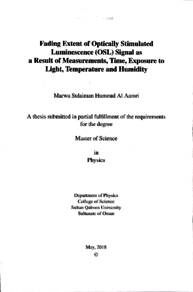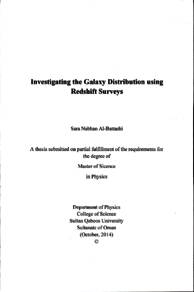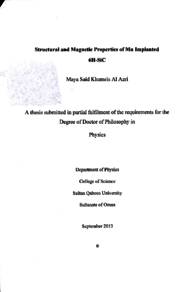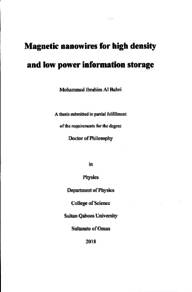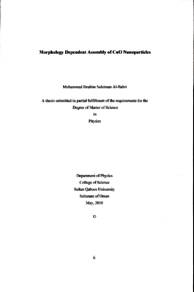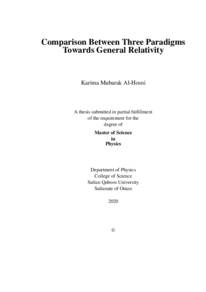Document
Study of antiferromagnetic coupling in thin films
Publisher
Sultan Qaboos University
Gregorian
2019
Language
English
Subject
English abstract
Nowadays, intensive studies have been devoted to the investigation of antiferromagnetic coupled (AFC) structures based on perpendicular magnetic anisotropy (PMA) materials for both fundamental research and technological applications. Although
the studies in such structures, it still needed to optimize the magnetic properties of these structures to use them in technological applications, especially, when reducing the size of the device to the nanoscale. Therefore, the aim of this research work is to fabricate and investigate AFC structures from soft (Co/Ni) and hard (Co/Pt) multilayers with PMA.
Then the interlayer exchange coupling strength Jex of the AFC structures is studied at a different range of temperatures. The twocandidates; (Co/Ni) and (Co/Pt) multilayers attracted enormous studies due to the possibility of tailoring their magnetic properties by
varying growth parameters. Particularly (Co/Ni) multilayers which consider as a promising candidate since they consist of both magnetic elements and hence possess high spin polarization and low damping constant.
In this work, (Co/Ni) multilayers with different repetition number N varied from 4 to 12 bilayers by a step of 2 have been investigated. The effect of the structure of magnetic multilayers on magnetic properties of fcc (111) (Co/Ni) multilayers has been
investigated by X-ray diffraction (XRD). XRD results reveal an increase in the intensity of (Co/Ni) multilayers peak as N increase which confirms the fcc (111) texture in as- deposited (Co/Ni) multilayers. However, a compressed strain induced by the seed Pt (111)
was observed which suggests a possibility of a magnetoelastic anisotropy contribution in PMA of (Co/Ni) multilayers. The magnetic properties were investigated experimentally by magnetic force microscopy (MFM) and Quantum Design physical property
measurement system (PPMS) and theoretically by a micromagnetic simulator known as oriented object micromagnetic framework (OOMMF). MFM results exhibit magnetostatic energy dominant by increasing N where the number of domains increases and the domain width decreases. The magnetostatic contribution can be seen in the shape of hysteresis loops measured by PPMS. As N increases a bow tie shape hysteresis loops can be observed and more obvious for 10 and 12 multilayers. The theoretical predictions by OOMMF simulation of the correlation between the saturation magnetization Ms and the anisotropy constant Ku are in contradiction with the experimental values obtained from the PPMS. The former predicts an inverse correlation between the values of Ms and Ku. However, the experimental values of Ku suggest an increase in both Ms and Ku values until N=8 and then drop for 10 and 12 multilayers. The influence of growth conditions and thermal fluctuations cannot be included in the micromagnetic simulation, for this reason, it shows different values for Ms and Ku. In this research, the structural and magnetic properties of the reference (Co/Pt) with 12 multilayers have been carried out by XRD and PPMS respectively. The out-of-plane hysteresis loops reveal a PMA of (Co/Pt) multilayers.
Building on the structural and magnetic properties of individual (Co/Ni) and (Co/Pt) multilayers, three samples of AFC structure are fabricated across Ru spacer with 0.8 nm thickness. In these AFC structure samples, the number of repeats N of (Co/Ni)
multilayers varied from 4 to 8 by a step of 2. The magnetic characterization of AFC structures is investigated at a temperature range of (25 K to 300 K).
[(Co/Ni)×4/Ru/(Co/Pt)×12] is the only sample that exhibits two distinct steps. On the other hand, no clear steps can be seen in AFC structure with 6 and 8 repeats of soft (Co/Ni). In [(Co/Ni)×4/Ru/(Co/Pt)×12], the interlayer exchange coupling Jex manifest a strong dependence on temperature with non-monotonous behavior. The maximum value of Jex is 0.13 erg/cm2 obtained at 150 K.
Member of
Resource URL
Arabic abstract
في الآونة الخيرة، دراسات مكثفة تم تكريسها من أجل التحقق من تراكيب اقتران المضادات المغناطيسية (AFC) و ذلك للاستفادة منها في الناحيتين الأساسية و التطببيقية. يهدف هذا البحث إلى صنع مواد اقتران المضادات المغناطيسية المعتمدة في تركيبها على المواد المغناطيسية التي يكون فيها اتجاه العزم المغناطيسي عمودية على إتجاه سطح الفيلم. على الرغم من الدراسات العديدة في هذا المجال إلا أن هذا النظام ما زال يحتاج إلى تعديل -خاصة عندما يتقلص حجم الأدوات المصنعة منه إلى قياس النانومتر- حتى يمكن استخدامه في التطبيقات التكنولوجية المختلفة. لذلك تهدف هذه الدراسة إلى صنع مواد اقتران المضادات المغناطيسية من نظامين هما: متعدد الطبقات للكوبالت (Co) و النيكل (Ni) والتي يتم فيها اختیار سمك معین لكل من الكوبالت (Co) و النيكل (Ni) و يتغير هذا النظام بتغيير عدد الطبقات، و النظام الآخر مكون من متعدد الطبقات للكوبالت (Co) و البلاتين (Pt) و التي يكون فيها عدد الطبقات مثبت على اثنی عشر طبقة. وكذلك يتم تحديد سمك معين لكل من الكوبالت والبلاتين ومن ثم التحقق من خصائص مواد مضادات الانجذاب المغناطيسي المقترنة و دراسة قوة الاقتران الداخلي في درجات حرارة مختلفة. استقطبت هذه الأنظمة اهتمام الباحثين نظرا لقدرة الباحث على التحكم بخصائص الطبقات المكونة لها عن طريق تغيير بعض العوامل أثناء صناعتها. متعدد الطبقات من الكوبالت و النيكل نال اهتماما خاصا بسبب تكوينه من مادتين مغناطيسيتين و بذلك فهو يتميز باستقطاب دوراني عالي بالاضافة إلى معامل تخامد منخفض.
في هذا البحث، تم تغییرتکرار عدد طبقات ال ( Co/ Ni ) من 4 إلى 12 بواقع تکرار 2 في كل مرة. تم استخدام حيود الأشعة السينية (XRD) لدراسة تأثير تكرار ترکیب متعدد الطبقات على الخصائص المغناطيسية و التي أظهرت زيادة في شدة قمة ال ( Co/ Ni ) بازدياد تكرار الطبقات و هو ما يعزز تحسن بنية (111) fcc. أما الخصائص المغناطيسية فقد تم دراستها بواسطة میکروسکوب القوة المغناطيسية (MFM)، و نظام قياس الخصائص المغناطيسية الكمي (PPMS). كما تم دراسة الخصائص المغناطيسية نظرية بواسطة نظام محاكاة يعرف ب (OOMMF). أظهرت هذه النتائج سيطرة الطاقة المغناطيسية الساكنة بازدياد تكرار عدد الطبقات وهو ما يظهر جليا في أشكال الحلقات عند تفاعل الطبقات مع المجال المغناطيسي. أما الدراسة النظرية أظهرت اختلاف في قيم معاملات الخصائص المغناطيسية نظرا لعم القدرة على ادخال بعض العوامل المتعلقة بالصنع والتأثيرات الحرارية في نظام المحاكاة.
بناء على النتائج التي تم الحصول عليها من دراسة متعدد الطبقات من ال ( Co/ Ni ) و ( Co/ Pt )، تم صنع ثلاثة تراكيب من مواد اقتران المضادات المغناطيسية وذلك بوضع سمك معين من فاصل معدني غير مغناطيسي و هو الروثينيوم (Ru). في هذه التراكيب تم تغيير تكرار طبقات ال ( Co / Ni ) من 4 إلى 8. أظهرت نتائج الخصائص المغناطيسية عندما يكون التكرار مساوي 4 فإن الطبقات تتصرف وكأنها معزولة عن بعضها ولذلك تتفاعل كل طبقة على حدة مع المجال المغناطيسي، وبذلك أمكن قياس قوة الاقتران الداخلي Jex في درجات حرارة تتراوح بين 25 كلفن إلى 300 كلفن. أظهر ال Jex سلوكا غير مألوف في مثل هذه التراكيب حيث وجدت أعلى قيمة له عند درجة حرارة 150 كلفن. أما بالنسبة لتغيير تکرار متعدد الطبقات من ال( Co/ Ni ) إلى 6 و 8 فقد أظهرت النتائج أن مواد اقتران المضادات المغناطيسية المشكلة لها تتفاعل مع المجال المغناطيسي وكأنها طبقة واحدة.
في هذا البحث، تم تغییرتکرار عدد طبقات ال ( Co/ Ni ) من 4 إلى 12 بواقع تکرار 2 في كل مرة. تم استخدام حيود الأشعة السينية (XRD) لدراسة تأثير تكرار ترکیب متعدد الطبقات على الخصائص المغناطيسية و التي أظهرت زيادة في شدة قمة ال ( Co/ Ni ) بازدياد تكرار الطبقات و هو ما يعزز تحسن بنية (111) fcc. أما الخصائص المغناطيسية فقد تم دراستها بواسطة میکروسکوب القوة المغناطيسية (MFM)، و نظام قياس الخصائص المغناطيسية الكمي (PPMS). كما تم دراسة الخصائص المغناطيسية نظرية بواسطة نظام محاكاة يعرف ب (OOMMF). أظهرت هذه النتائج سيطرة الطاقة المغناطيسية الساكنة بازدياد تكرار عدد الطبقات وهو ما يظهر جليا في أشكال الحلقات عند تفاعل الطبقات مع المجال المغناطيسي. أما الدراسة النظرية أظهرت اختلاف في قيم معاملات الخصائص المغناطيسية نظرا لعم القدرة على ادخال بعض العوامل المتعلقة بالصنع والتأثيرات الحرارية في نظام المحاكاة.
بناء على النتائج التي تم الحصول عليها من دراسة متعدد الطبقات من ال ( Co/ Ni ) و ( Co/ Pt )، تم صنع ثلاثة تراكيب من مواد اقتران المضادات المغناطيسية وذلك بوضع سمك معين من فاصل معدني غير مغناطيسي و هو الروثينيوم (Ru). في هذه التراكيب تم تغيير تكرار طبقات ال ( Co / Ni ) من 4 إلى 8. أظهرت نتائج الخصائص المغناطيسية عندما يكون التكرار مساوي 4 فإن الطبقات تتصرف وكأنها معزولة عن بعضها ولذلك تتفاعل كل طبقة على حدة مع المجال المغناطيسي، وبذلك أمكن قياس قوة الاقتران الداخلي Jex في درجات حرارة تتراوح بين 25 كلفن إلى 300 كلفن. أظهر ال Jex سلوكا غير مألوف في مثل هذه التراكيب حيث وجدت أعلى قيمة له عند درجة حرارة 150 كلفن. أما بالنسبة لتغيير تکرار متعدد الطبقات من ال( Co/ Ni ) إلى 6 و 8 فقد أظهرت النتائج أن مواد اقتران المضادات المغناطيسية المشكلة لها تتفاعل مع المجال المغناطيسي وكأنها طبقة واحدة.
Category
Theses and Dissertations

